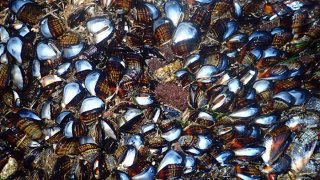
UC San Diego scientists reported Monday that increased ocean acidity is weakening California mussel shells along the Pacific Coast, a result of rising levels of human-produced carbon dioxide.
The large mollusk known as the California mussel makes its home in the rocky shoreline from Mexico to Alaska. It is considered a "foundational" animal, as it provides homes for hundreds of other species and offers a rich food source for species ranging from spiny lobsters to humans.
As the mussel becomes more tolerant of acidic conditions, the shells are changing to a weaker composition, according to the UCSD scientists.
As ocean waters increasingly acidify due to absorbing carbon dioxide, tracking impacts on specific species has been difficult to gauge over time. Most of what is known about species' responses to acidifying waters comes from short-term experiments that suggest increases in ocean acidity -- causing a lowering of seawater pH and less availability of carbonate ions to make shells -- can lead to less fortified shells and more vulnerable animals. But not every species from the studies responds the same way, with some even appearing to do better under those conditions.
Comparing new data with samples collected in the 1950s, UCSD's Division of Biological Sciences graduate student Elizabeth Bullard and Professor Kaustuv Roy found that ocean acidification is transforming the composition of California mussel shells from mostly the mineral aragonite to the mineral calcite. The results are published in the Proceedings of the National Academy of Sciences.
Aragonite is much stronger than calcite and makes for a better shell to protect against predators and wave energy, two things that are expected to increase with warming waters. Calcite, on the other hand, is much weaker but does not dissolve as easily as aragonite -- making a better shell material if the waters are acidifying.
"We found that these mussels are indeed secreting more calcite today than they were 60 years ago," Bullard said. "Lower pH eats away the shells these animals are able to create, so it's considered a major problem for marine organisms. There are 303 species that are associated with the California mussel, so if we lose the mussel we lose other species, some of which are really important to things like our fisheries and recreation."
California
News from across California
In the late 1950s, Caltech scientist James Dodd traveled the Pacific Coast, collecting mussels along the way. His specimen sampling led to a baseline of information about mussels and their shell composition, including the ratio of aragonite to calcite. One of the results of his work was a stark geographical contrast between cold northern waters, where mussels mostly featured calcitic shells, with the warmer southern waters where aragonite was the dominant shell mineral.
To find out how the shell mineral profile has changed across six decades, Bullard similarly traveled the coastline with her labmate, graduate student Alex Neu, in 2017 and 2018 to collect new specimens in a survey that geographically replicated Dodd's sampling.
Project collaborator Olivia Graeve and the professor's materials science group in the UCSD Jacobs School of Engineering conducted X-ray diffraction analysis on each sample to determine their mineral profiles.
The results told a new story. Instead of a geographical boundary between north and south California mussel shells, the new survey revealed that acidic waters are reducing shell aragonite throughout the coast, leading to calcite as the dominant shell mineral.
"James Dodd's data fit in a world where the balance of temperature and ocean pH was very different from that today," said Roy, a professor in the section of ecology, behavior and evolution. "For me it was surprising how big the effect was in 60 years. That's not a huge amount of time as these things go, but the effect was striking."



